Follow These Steps When Repotting a Fiddle Leaf Fig
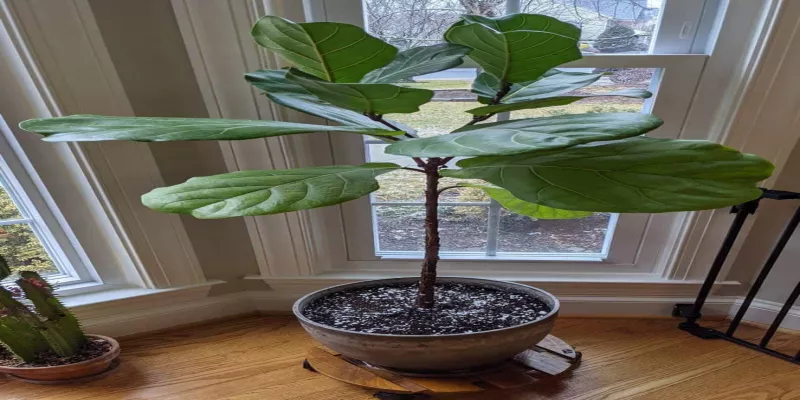
Fiddle Leaf Figs are having a moment in the spotlight right now. They have been a mainstay in the houseplant world, but have really grown in popularity the past few years. And why not? Show me a houseplant lover that doesn’t want a literal tree in their home. It can be hard to decide when to repot Fiddle Leaf Fig. I noticed my Fiddle Leaf Fig was in need of a repotting when I was doing my watering rounds the other day. I’m documenting the process for you here as a guide to repotting Fiddle Leaf Figs.
When to Repot Fiddle Leaf Fig
If you are planning a Fiddle Leaf Fig repot, then the best time of year is in the winter when it’s dormant. Otherwise, there are some more urgent reasons you will see below that may cause you to repot your Fiddle Leaf Fig outside of the dormant period.
Roots are Growing Out of the Pot
I’ll use my actual example first. As I mentioned, I was making the watering rounds when I noticed roots had grown out the bottom of my pot. They had grown so long they were visible without even lifting the pot. Your roots could also be peaking out of the top of the pot. Either could be a sign to repot a Fiddle Leaf Fig.
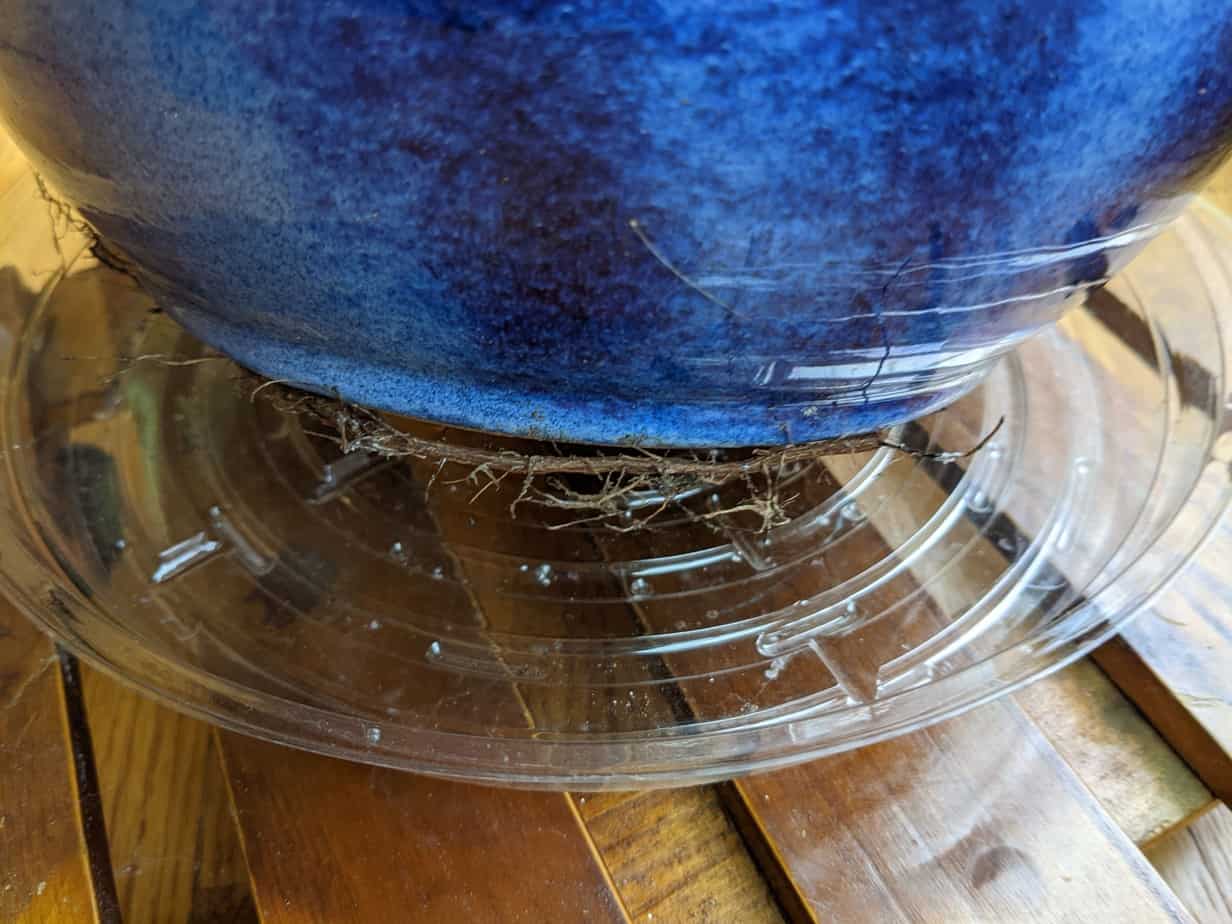
Fiddle Leaf Fig is Not Drying Out or Drying Out Too Quickly
You should be checking your soil moisture routinely. I use a cheap moisture meter to take the guesswork out of it. I only water my Fiddle Leaf Fig when the soil reads at the dry level. I also make sure to take moisture measurements in a few spots in the pot. If your plant is drying out too quickly it may be that there’s not much soil left to hold moisture or your soil has become hydrophobic. Yes, it’s a real thing, soil can become hydrophobic. Conversely, your plant could be staying moist for too long if the pot is too big or you are watering too much or too frequently. All of these are reasons to take the peak at the roots to see if you need to repot your Fiddle Leaf Fig.
Slow Growing
We just talked about dormancy earlier. As the days get shorter, your plant will become dormant. Dormancy does not mean you need to repot. If your Fiddle Leaf Fig has slowed growth during the growing season, that could be an indication that it needs to be repotted. You’ll need to check the roots to confirm. Slow growth during the growing cycle could also be due to soil moisture, soil fertility, disease, or pests.
Repotting Fiddle Leaf Figs
Repotting Supplies
Pot
In most cases, you will be repotting your Fiddle Leaf Fig into a new larger pot. The general consensus is to go for a pot that is two inches larger than your current pot when you are potting up. This gives your plant room to grow new roots. Your new pot must have a drainage hole if you want to keep your plant healthy. Pots for Fiddle Leaf Figs can get expensive because they are large. I often go for terracotta because they are cheap, but during this pandemic, terracotta pots are hard to come by online. I opted for this pot for its size and price point. I do like the concrete look as well.
Fiddle Leaf Fig Soil
Fiddle Leaf Figs don’t need a special kind of soil. It’s being kept in a pot, so traditional potting soil will work the best. I like to add extra perlite to almost all of my plants to facilitate drainage as well. If you are repotting your Fiddle Leaf Fig because of a watering issue, you should use perlite.
Things You Might Need
- A garden trowel to help loosen the plant from the pot.
- Gloves if you want to keep your hands clean
- Plant pruners. If you are having watering issues you may have to remove some root rot.
Remove the Fiddle Leaf Fig From the Old Pot
Loosen your Fiddle Leaf Fig from its old pot. Some roots may be stuck to the inside of the pot. If that’s the case, use a small garden trowel to get it loose. If you have roots growing out of your drainage holes like me, try to untangle them so they can be removed with the plant. Be careful while doing all of this. Try to cause as little damage to the roots as possible. Below you can see I have untangled the roots so they can fit through the two drainage holes.
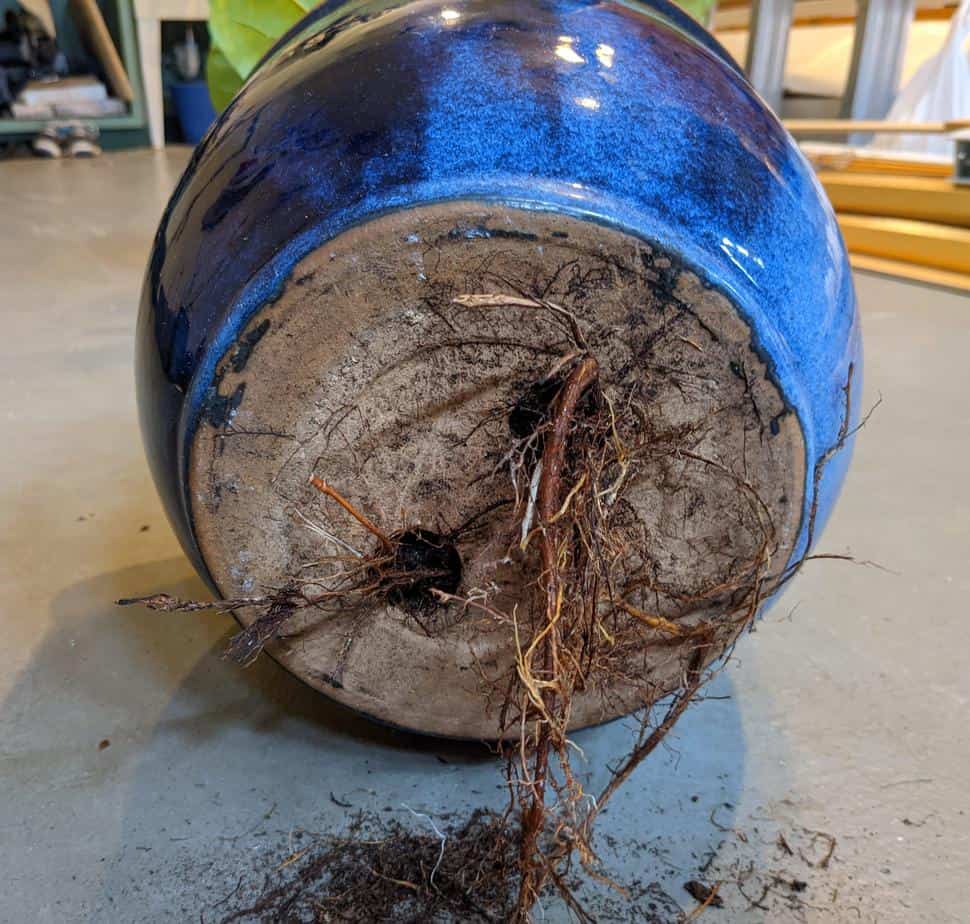
Inspect the Root Ball and Loosen it
If you were repotting your Fiddle Leaf Fig because of watering issues, this step is crucial. Take a close look at the roots. Rotten roots will look brown and mushy. If you see that, you need to remove all the rotten plant material from the root ball. Use sharp clean plant pruners to do so. The roots on my Fiddle Leaf Fig are both brown and white, this is normal. The older more mature roots can be brown. The most important thing is none of these roots are mushy.
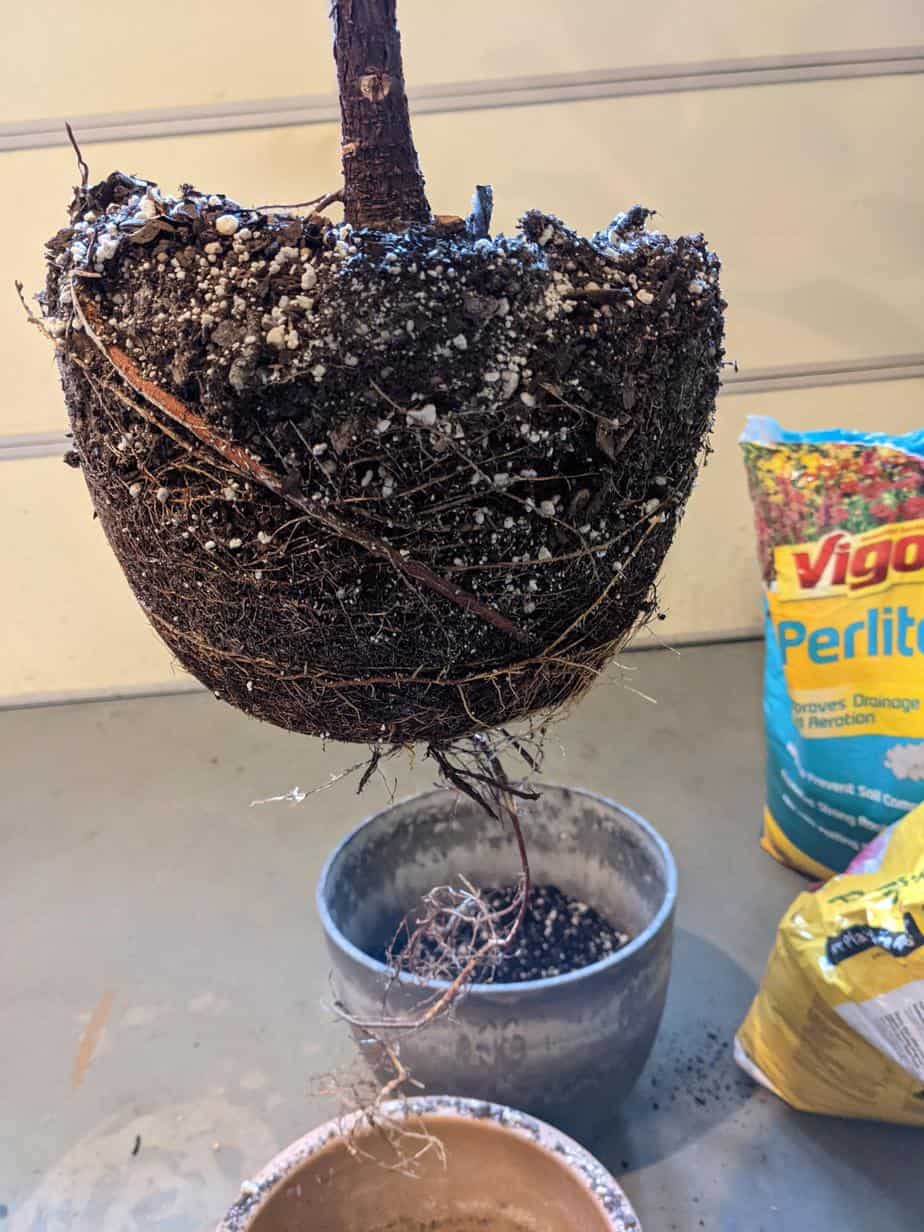
It’s also a good idea to delicately loosen up the existing root ball. That makes more room for growth. It also shakes out some of the old worn-out soil. You do not need to remove all or even most of the soil from your root ball. That’s not to say you can’t, but it will be a much bigger shock to your plant and in my experience, it is not necessary as long as you are fertilizing your plant.
Potting Up a Fiddle Leaf Fig
Prep your new pot by first placing a small square of paper towel over the drainage hole. This keeps the Fiddle Leaf Fig soil from falling through the drainage hole, but it still allows water to flow freely. Next fill in your new pot with potting soil and perlite. The perlite instructions say to add 25% perlite, but I just eyeball it. Don't add all the soil at once or else it will be difficult to place your Fiddle Leaf Fig root ball far enough into the pot.
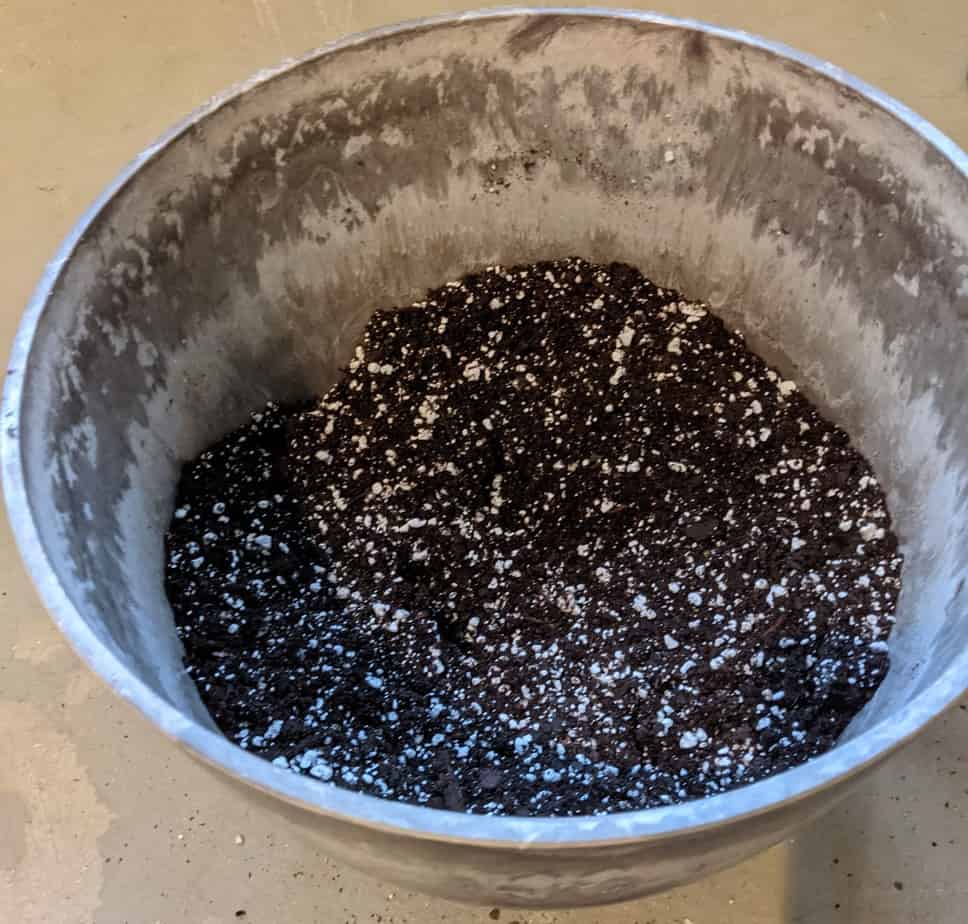
Place the root ball in the pot and then backfill the same potting soil and perlite mixture into the remainder of the pot. Take a step back and make sure your Fiddle Leaf Fig is upright and not leaning too far in any direction. Take a look from several sides to get it right. With tall houseplants, it can be problematic if you plant your tree at an angle as it can be a tipping hazard.
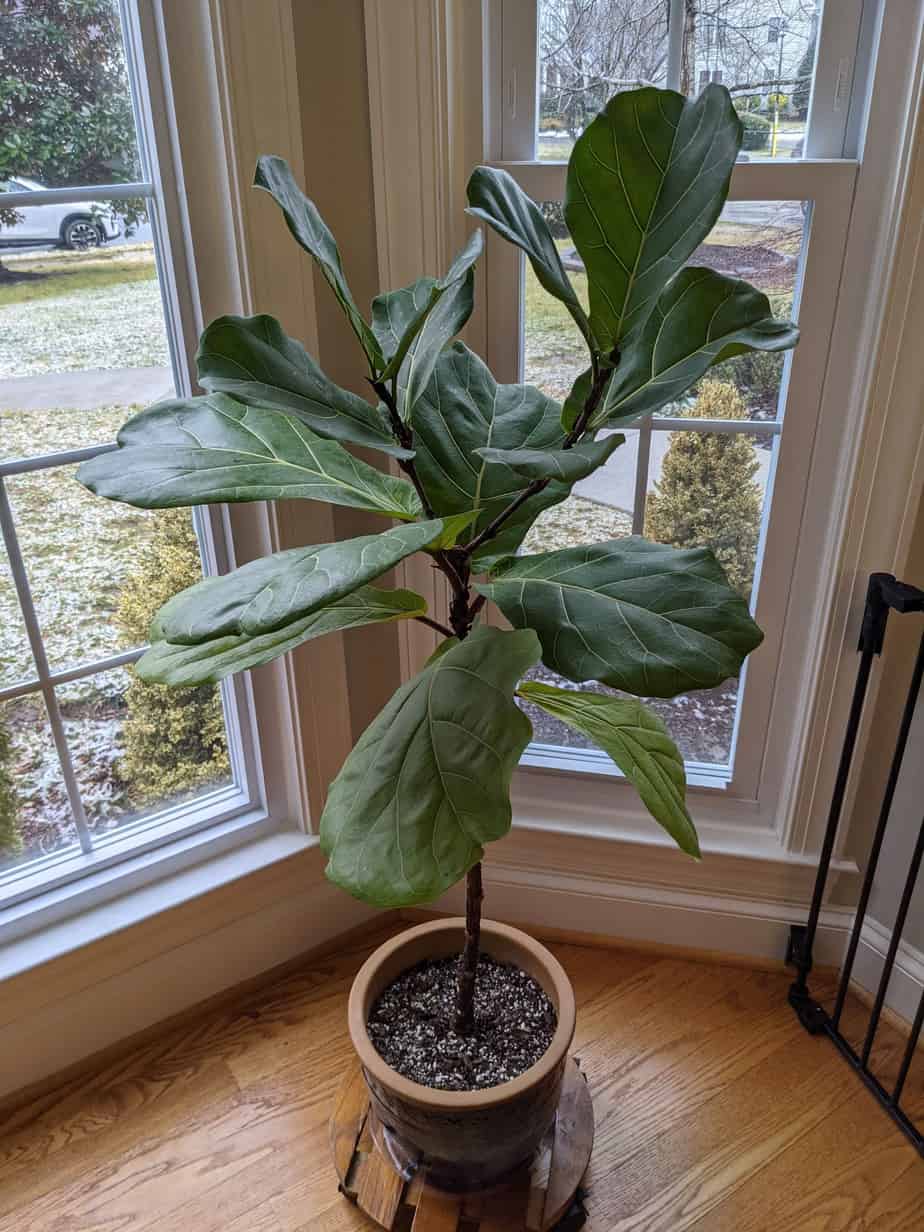
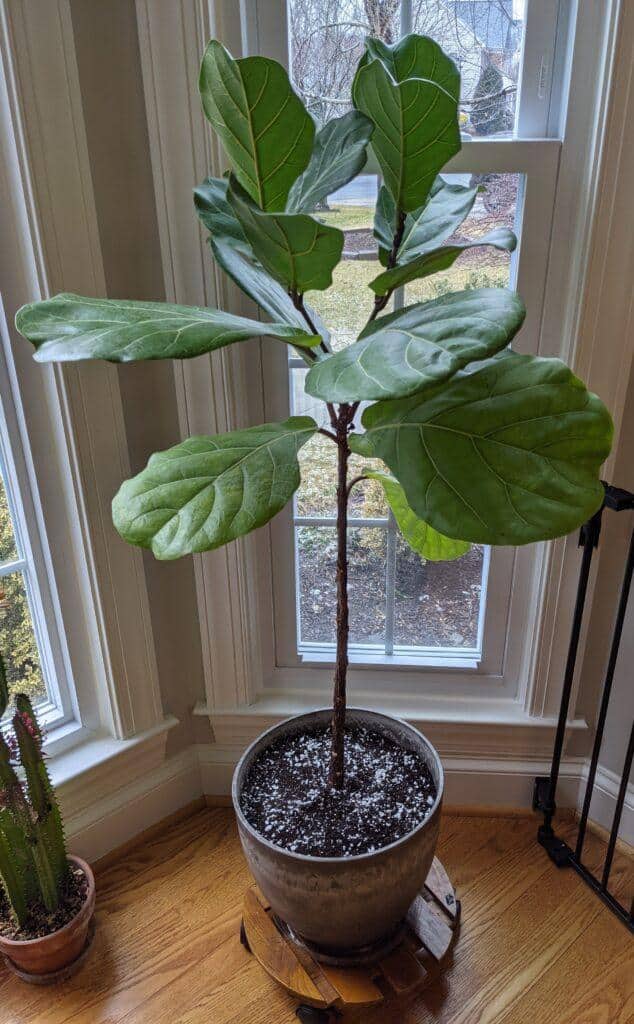
What to do After Repotting a Fiddle Leaf Fig
Keep it in the Same Spot
Keep your Fiddle Leaf Fig in the same spot you had it before. They can be dramatic, so reducing shock-causing factors will help. If you’re bringing home a new Fiddle Leaf Fig and repotting it, you have no choice obviously. You will help your plant out by providing it the same environment (e.g. light and temperature) it was used to.
Watering After Repotting
I usually wait a day or two to water after repotting. You also need to be conscious of the new watering needs of your plant and pot combination. Larger pots will take longer to dry out, especially because the roots have not grown into it yet. Do not stick to your old watering schedule, you need to figure out a new one.
Fertilizing After Repotting
Fiddle Leaf Figs repotted during the dormant period do not need fertilizer. You should not be fertilizing your plant in the dormant period anyway. If you repotted during the growth cycle, then you can skip a dose of fertilizer. The new potting soil will have some fertilizer in it already and you don’t want to shock your plant.
Fiddle Leaf Figs can be dramatic about shocks. Repotting can be a shock, so if your plant drops a leaf or looks a little sad at first, don’t panic. Stick with your normal care routine and it should bounce back stronger with its new pot and soil.
Add new comment